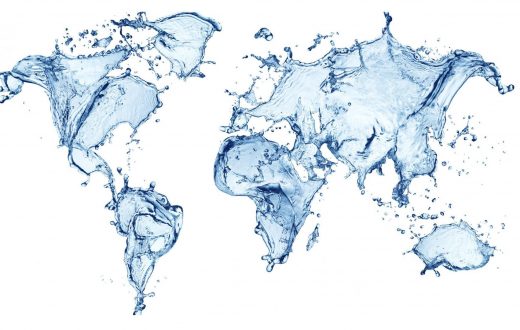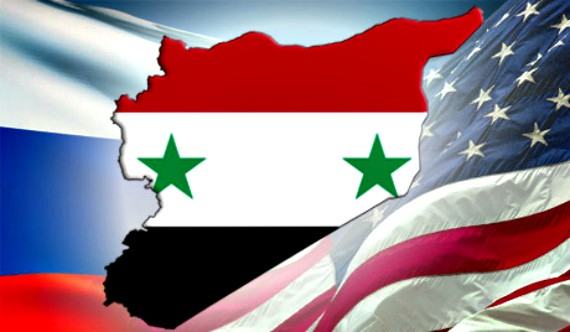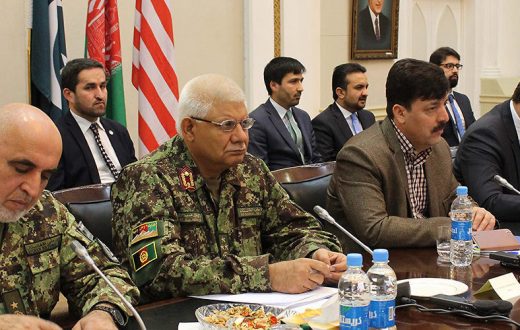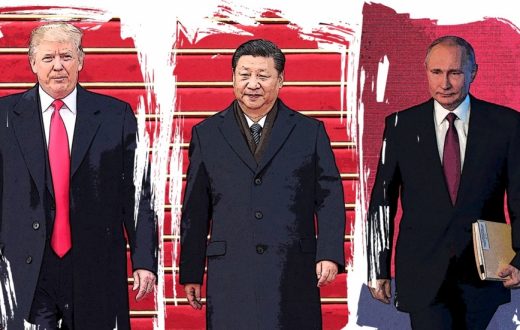This article is a repost of Newseek article available here and written by Owen Matthews, Jack Moore and Damien Sharkov. On the morning of January 11, Field Marshal Khalifa Haftar climbed up the companionway of an aircraft carrier floating off the Mediterranean port of Tobruk. As a Marine band played and an honor guard presented arms, an admiral in a white full-dress uniform greeted the Libyan strongman, who was a senior commander in the U.S.-backed rebel forces that ousted the dictator Muammar el-Qaddafi in 2011. After the welcoming ceremony, the 73-year-old Haftar, an American citizen who for many years lived in the United States, was escorted below decks for a secure video conference with the Middle East’s most energetic foreign power broker. The official topic was battling terrorists. But both sides knew the unofficial agenda was something else: how to boost Haftar’s power as he tries to defeat a weak, U.N.-backed government in Tripoli.
Haftar has close ties in Washington, but his hosts in January were not American. Rather, he was aboard the Admiral Kuznetsov, Russia’s only aircraft carrier, and his interlocutor was Russian Defense Minister Sergei Shoigu.
Like a growing number of leaders in the Middle East, Haftar has a new set of friends in Moscow. After three decades on the sidelines, Russia is once again a major player in the region. In the last six months alone, the country has altered the course of the Syrian civil war and taken control of the peace process, forged a close relationship with Turkey’s strongman President Recep Tayyip Erdogan and has been courting traditional U.S. allies such as Egypt, Saudi Arabia and even Israel. And over the past two years, Russian President Vladimir Putin has received the leaders of Middle Eastern states 25 times—five more than former U.S. President Barack Obama, according to a Newsweek analysis of presidential meetings.
For decades, Washington has tried to plant democracies in much of the world, including the Middle East. But that plan appears to have withered under Obama and current U.S. President Donald Trump. With the imperfect exception of Tunisia, the Arab Spring did not bring democracy to the Middle East. It instead allowed instability and extremism to flourish in countries including Egypt, Libya and Syria. Western intervention in Libya and Yemen—together with the involvement of Iran and a Saudi-led coalition in Yemen—helped produce failed states that are still mired in civil wars. Backing the Syrian rebels and insisting that autocratic President Bashar al-Assad shouldn’t stay allowed Syria’s civil war to drag on, or even intensify—fueling the rise of the Islamic State militant group (ISIS). And a two-state solution between Israel and the Palestinians—a longstanding goal of U.S. foreign policy—now seems further away than ever. After Obama’s two terms, only last year’s historic Iran nuclear deal, which curbed Tehran’s nuclear program in return for lifting sanctions, remains as the lone regional success story—and even that looks shaky under the new administration.
“Obama’s entire policy in the Middle East has failed,” says Leonid Slutsky, chairman of the Russian Duma’s committee on foreign affairs. “The powerlessness and the lack of results are evident.”
Observing the U.S.’s setbacks, the Kremlin sensed an opportunity. For Moscow, the advantages of clawing back some of the Soviet Union’s old influence in the Middle East are manifold: Russia can continue empire-building and projecting its growing global influence and military heft; it can also gather diplomatic bargaining chips to exchange for softening of Western sanctions imposed after the 2014 annexation of Crimea—or for future use in negotiations with the West.
“First and foremost this is a question of regaining our strategic influence,” Senator Oleg Morozov, a member of Russia’s Federation Council international affairs committee, tells Newsweek. Or, as Dmitri Trenin, director of Moscow’s Carnegie Center, puts it: “The goal of [Putin’s] foreign policy is to restore Russia as a global major power. For him to be able to operate in the Middle East, in competition with the U.S., is a badge of [being] a major power. That is what Russia did in Syria.”
But perhaps more important than either of these goals—and a motivation little understood in the West—is Moscow’s desire to protect Russia from radical Islamist terrorism, the fear of which helped Putin ascend to power during the brutal wars in Russia’s North Caucasus in the 1990s. Russia’s homegrown insurgencies shaped its politics so that the Kremlin—and many Russians—favors order over personal rights and freedoms. After watching the U.S. a decade later try to import democracy to Iraq and Libya, only to see them crumble into civil strife, Putin saw a stark choice: Outside powers could side with strong regimes, however ruthless they might be, or the world will witness what he called “the destruction of state systems and the rise of terrorism.”
As ISIS grew more influential in Syria, so did Putin’s mistrust of Western efforts to combat the militant group. In mid-September 2015, Russia’s security services announced that there were at least 2,500 Russian nationals fighting for ISIS. In Putin’s eyes this was enough to make the survival and success of Assad’s regime a matter of national security for Russia.
“Our main aim in Syria is to make sure that our citizens who went out there [to fight with ISIS] never come back,” says Vyacheslav Nikonov, a Duma member. “For Russia, intervention in the Middle East is a matter of defending our own security. All the rest is details.”
Power and Paranoia
For much of the Cold War, the Middle East was as much Moscow’s turf as it was Washington’s. The Soviet Union was the self-declared champion of proletarian revolution around the world. The anti-Western, strongly socialist Arab nationalism of Egyptian President Gamal Nasser gave Moscow an opening to spread its influence over the Arab world. After Nasser’s defeat of the region’s old colonial masters—Britain and France—in the 1956 Suez Crisis, Russian arms and money began pouring into the region. Soviet engineers dammed the Nile at Aswan, and helped construct modern cities in Baath Party-run Syria and Iraq. At the same time, an entire generation of Arab officers, doctors and professionals studied in Moscow—including future Egyptian President Hosni Mubarak and Haftar, who received training in the Soviet Union in the 1970s after graduating from Benghazi Military Academy. KGB generals helped build the security services of Libya, Algeria, Egypt, Iraq and Syria in the image of the Soviet secret police.
Anxious to stop the Communist domino effect in the Middle East, Washington threw money at the problem. Israel, Saudi Arabia and Egypt—after Nasser’s fall—became major recipients of U.S. military aid. Turkey, a NATO member since 1952, hosted American planes, warships and, most controversially, Jupiter medium-range missiles—a deployment that prompted the Soviets to place rockets in Cuba, nearly triggering nuclear war in October 1962.
After the collapse of the Soviet Union in 1991, Moscow’s friends in the region clung to power, maintaining a stoutly anti-Western crescent from Libya to Syria despite the lack of Russian rubles. Then, one by one, Moscow’s clients began to fall. Iraq’s Saddam Hussein—who had at times received U.S. support—was the first to go, ousted in 2003 by what Russia described as naked American aggression. A decade later, the 2011 Arab Spring claimed Libya’s Muammar Gaddafi, Egypt’s Hosni Mubarak and Tunisia’s Zine El Abidine Ben Ali. Throughout this period, parallel waves of revolt in the former Soviet Union—the so-called Color Revolutions—also ousted pro-Russian governments in Serbia, Ukraine, Kyrgyzstan and Georgia. In 2011, the yearning for greater democracy even reached Moscow, where 100,000 people poured into the streets to protest Putin’s return for a third presidential term.
For Americans, the series of protests seemed to mark a triumph of democracy and people-power. But for Russians, the Arab Spring appeared to be part of a Washington-orchestrated campaign to destroy any leader who dared to oppose the U.S.—including Putin. His approval rating slid to a historic low (63 percent) as protest leaders, who spoke of European liberalism and rapprochement with the U.S., seemed genuine contenders for power.
In Putin’s eyes, “[Cairo’s] Tahrir Square and [Kiev’s] Maidan are all part of the same conspiracy against Russia,” says one senior Western diplomat in Moscow who was not authorized to speak on the record. “We dismissed that as paranoia. It is paranoia. But they believe it.”
Throughout this period, Russia regularly protested—and was regularly ignored—at the U.N., in futile attempts to prevent the bombing of Belgrade in 1999 and the invasion of Iraq in 2003. The U.S. overrode Moscow both times. It was only by cosying up to Iran that Russia got Washington’s attention. In the late 1990s, Moscow helped Tehran develop the Shahab-3 intermediate-range ballistic missile and later began to build Bushehr, Iran’s first nuclear power plant. From 2008 onward, as the White House inched toward a deal to persuade Tehran to give up its nuclear weapons program, Russia began to play the role of an honest broker.
“Americans realized they needed our help with Iran,” says former Russian Prime Minister Sergei Kiriyenko, who was the head of the Rosatom state nuclear energy corporation during the key Iran negotiations. “The Iranians trusted us. We were their guarantee of security.”
At the same time, Russia was also inserting itself, steadily and quietly, into the Israeli-Palestinian peace process. Moscow’s key ally was Palestinian leader Mahmoud Abbas, who earned a doctorate at the Peoples’ Friendship University in Moscow in the 1970s. Israeli researchers, citing documents that KGB archivist Vasili Mitrokhin smuggled out of Russia in 1991, have claimed that Abbas was recruited by the Soviet security service under the code name “Krotov”—although Palestinian officials dismissed the allegation as an Israeli smear.
Agent or not, Abbas “likes the Russians, he wants to please them,” says Ziad Abu Zayyad, a former Palestinian minister and negotiator. When Putin visited Bethlehem during a 2012 trip to the West Bank, Abbas gave him a plot of land—now a Russian cultural center; that year, he named streets in Bethlehem and Jericho after Putin and his predecessor, Dmitry Medvedev.
Running in parallel with these grand, public gestures of friendship is a quieter and constant diplomatic campaign in the region. Spearheading Moscow’s outreach is a bespectacled, Arabic-speaking, 64-year-old career diplomat named Mikhail Bogdanov, who has been Putin’s special envoy to the Middle East since 2012. A former ambassador to Syria, Egypt and Israel, Bogdanov has played a key role in winning friends and influencing people, from Egypt’s president and military strongman, Abdel Fattah el-Sisi, to Libya’s Haftar.
America’s steady disengagement from the Middle East under Obama helped Bogdanov. The White House had good reason to step back from the region: The president wanted to wind down unpopular American military interventions. At the same time, America was becoming less dependent on Middle Eastern oil thanks to a domestic shale gas revolution that has transformed the U.S. into an energy-exporting country. But one unintended consequence was to allow Bogdanov to strike deals from Ramallah to Cairo and Benghazi, Libya.
“The nature of the Russian regime’s foreign policy is extreme pragmatism, the absence of ideology and the attempt to deal with all the main players in a region,” says Nikolay Kozhanov, former attaché at Russia’s embassy in Tehran, now with U.K. think tank Chatham House. “So this should be considered as the main principle of Russia’s strategy and its main advantage in the Middle East.”
Unlike his American counterparts, Putin didn’t lecture Egypt and Syria on democracy and human rights. “Russia saw an opportunity in Egypt because the U.S. has pushed for a reform environment since the Arab Spring,” says Steve Seche, a former State Department official and U.S. ambassador to Yemen. The Russian president was also ready to sell cheap arms to regional powers. Moscow has sold $4 billion worth of weapons to Egypt since 2012, and began talks with Iran over a $10 billion deal in November 2016.
But two crises took the Middle East from the sidelines of Russian foreign policy to front and center: Russia’s annexation of Crimea in February 2014, which put Moscow in direct conflict with the West, and, a year later, the war in Syria, which offered Putin an opportunity to make sure Russia would become one of the primary power brokers in the Middle East.
The Damascus Gambit
On September 30, 2015, Putin ordered a squadron of Russian jets to deploy to the Hmeymim airbase near Latakia, a stronghold of Assad loyalists. It was Russia’s first military deployment outside the former borders of the Soviet Union since Moscow’s disastrous 1979 invasion of Afghanistan. Within days, some 30 Russian warplanes had already begun to turn the war in Assad’s favor.
Though the deployment was tiny, it was a pivotal moment for Moscow’s foreign policy. Suddenly, Russian planes were flying in the same airspace as those of America and its allies, who were battling ISIS. At home, Kommersant radio claimed the Syrian people were hailing Putin as “Caesar,” while daily weather reports on Russian news began featuring the bombing conditions over Syria. By the end of 2016, Russia’s defense ministry boasted that its jets had performed 30,000 sorties and hit 62,000 targets. The U.S.-led coalition, by contrast, flew 135,000 missions against ISIS in Syria and Iraq between 2014 and the end of January 2017 but damaged fewer than 32,000 targets. The main reason: what the coalition says are strict rules to limit civilian casualties. In January, U.S. Defense Secretary Ashton Carter complained that Russia’s air war has done “zero” to degrade ISIS. Whatever the impact of the Russian air campaign, most agree it has helped deplete U.S.-backed rebel forces and allowed Assad to regain control of the strategically vital city of Aleppo.
Senator Oleg Morozov, a member of Russia’s Federation Council international affairs committee, says Putin “had no choice other than to step in. It’s not so much that we need Assad in place—but we need some kind of stability in Syria. If we had allowed Assad to fall, that would have been the end of our influence on the Middle East.”
Either way, the Syria campaign quickly became Putin’s symbolic rebuke, says Trenin, to Obama’s claims a year prior that Russia was just a “regional power” and a “desperate” one at that.
The symbolic peak of Russia’s self-appointed role as Syria’s “savior” came on May 5, 2016, just days after Assad’s troops backed by Russian special forces and close air support seized the ancient city of Palmyra from ISIS—though most Russian airstrikes were against U.S.-backed rebel groups in the center of the country. Moscow flew in its greatest conductor, Valery Gergiev, and his Mariinsky Symphony Orchestra to play before an audience of international journalists in the ancient theater at Palmyra, which ISIS had previously used as a venue for public executions. A publicity stunt, sure—but an immensely effective one.
Russia’s success in Palmyra didn’t last long—but that didn’t seem to matter: In December, seven months after the Russian orchestra played, cameras and—most importantly—troops left, and ISIS retook the city. The Kremlin blamed lack of cooperation from the U.S. for the defeat and Moscow has seldom mentioned Palmyra since.
But now with Aleppo in regime hands and the peace process being run by Moscow, the new U.S. administration has little influence on the Syrian endgame either diplomatically or on the ground.
“What can we do to counter it?” a State Department official, speaking on condition of anonymity, tells Newsweek . “[Russia has] become very influential in Syria because they have elected to engage in behavior which, in any other part of the world, would be condemned as war crimes.”
Enemies With Benefits
Over the past 18 months, Russia’s successful intervention in Syria supercharged Moscow’s position in the region. The Kremlin’s unlikely new best friend is Turkey, a NATO member and centuries-old foe of Russia. Just a year ago, when Turkey shot down a Russian plane after a 17-second incursion into Turkish airspace, Putin was furious; in retaliation, he ordered the suspension of Russian charter tourist flights to Turkey and imposed sanctions on Turkish goods.
Since then two things have transformed the relationship between Moscow and Ankara—Assad’s victory in Aleppo, and the failed July coup that prompted Erdogan to initiate a purge of his opponents, earning criticism from the U.S. and Europe alike. In response to stinging rebukes from his one-time allies in Brussels and Washington, Erdogan has turned to his “friend Vladimir” in Russia.
“Without Russia it is impossible to find a solution to the problems in Syria,” Erdogan said in August, in a Russian TV interview before visiting Putin in St. Petersburg. “The axis of friendship between Moscow and Ankara will be restored.”
At the same time, Erdogan acknowledged that his relationship with Obama was “disappointing.” The Obama administration refused to cease support for Kurdish anti-ISIS fighters in northern Syria and it has declined to extradite Fethullah Gülen, a U.S.-based cleric who is an Erdogan foe, to Turkey. As a result, Turkish officials have openly questioned America’s use of the strategic Incirlik base in Adana, near the Syrian border. Erdogan has urged Turkish politicians to re-evaluate their “fixation” with the EU and instead consider joining the Chinese-led Shanghai Cooperation Organization, which Moscow also favors. In January, for the first time, Russian and Turkish warplanes participated in joint airstrikes against ISIS.
The new friendship may be “transactional,” says Fadi Hakura, head of the Turkey Project at Chatham House, but it suits both countries. Erdogan wants to “increase the distance between Washington and Ankara”—something Russia is only too keen to encourage on the time-honored principle that my enemy’s enemy is my friend.
Russia’s friendship with one of the region’s other major powers, Iran, may have begun as an alliance of outcasts—but it now appears formidable. Tehran has joined Moscow in taking control of the Syrian peace process, becoming joint arbiters of talks in Astana, Kazakhstan, in January that outlined a roadmap to peace and a new constitution for Syria that will inevitably reflect Assad’s military victories on the ground. Russian arms supplies—including an S-300 anti-aircraft missile system delivered last year—have helped Tehran keep up with massive military spending by its regional rivals Israel and Saudi Arabia. In exchange, Iran gave Russia temporary access to its Hamadan air base for raids on Syria and allowed Moscow to fire cruise missiles from warships in the Caspian Sea over its territory en route to Aleppo. And most crucially, says Sir Richard Dalton, a former British ambassador to Iran, by keeping Assad in power, Russia helped Tehran maintain “an axis of resistance against Israel and the United States.”
While Iran has not been a U.S. ally for decades, Cairo has long been a key military, intelligence and diplomatic partner for Washington. As the recipient of the second-largest amount of U.S. military aid, Egypt continued this partnership even when relations with Obama strained following Sisi’s power grab in 2013. While close ties with Washington have been maintained since then, Egypt has also acknowledged Moscow’s new-found status by hosting an air drill for Russia last year—the Kremlin’s first such exercise in Africa. Last November, Egypt also signaled its support for Putin by becoming one of only four countries to support Russia’s resolution on Syria in the United Nations. Moscow, in turn, has pushed to lift U.N. sanctions on Libya, where Haftar, Sisi’s ally, is still vying to become the country’s military strongman. “Putin will undertake to revoke [sanctions],” Haftar told reporters after his video conference in January with Shoigu on Russia’s aircraft carrier.
Putin has even achieved new levels of friendship with Israel, Washington’s closest and most important ally in the Middle East. Russian jets now operate within reach of the Golan Heights, a contested territory that Israel captured from Syria in the 1967 War and now divides the two countries. Israeli Prime Minister Benjamin Netanyahu has visited Putin in Moscow three times since September 2015 — more than he has visited Obama, with whom he had a notoriously rancorous relationship. Medvedev traveled to Israel in November last year to mark 25 years of diplomatic ties between the two countries, and to boost trade. Netanyahu is obviously concerned about Russia’s cooperation with two of Israel’s main enemies, Iran and the Lebanon-based Shiite militia Hezbollah. He hopes to harness Russian influence with Israel’s enemies to his benefit, and, so far, Moscow has not objected when Israel has conducted strikes against Hezbollah in Syria. But Netanyahu had concerns about the U.S., too: Obama overruled Israeli objections to a nuclear deal with Iran and pressured the Israeli leader to stop settlement building in the West Bank, a main obstacle to reaching a peace deal with the Palestinians. On February 2, the White House press secretary Sean Spicer echoed Obama’s policy, saying “ the construction of new settlements or the expansion of existing settlements beyond their current borders may not be helpful in achieving” peace.
Russia, on the other hand, makes no such tiresome demands of Israel. After Washington set sanctions on Russia following the annexation of Crimea, Putin has been pushing to make all the friends he can get in the region in order to “develop a second front,” says Zvi Magen, former Israeli ambassador to Russia. Putin “needs more leverage with the West.… One [such lever], the new one, is the Israeli-Palestinian process.” After Putin and Netanyahu’s third meeting in Moscow in June—in which the Russian leader called Israel an “unconditional” ally—Russia offered to host peace negotiations in Moscow between Netanyahu and Abbas. In this blossoming relationship, based on pragmatism, both leaders saw an opportunity: for Netanyahu, a pivot from the Obama administration; for Putin, a challenge to Washington’s leadership. There’s a lot of win-win situations developing in the Middle East right now. Unfortunately, none of them apply to the United States.
Partner or Spoiler?
Obama may have retreated from employing Bush-like American force in the Middle East—and elsewhere—but it seems that Trump is intent on entirely abandoning America’s 70-year-old, bipartisan commitment to being the world’s most determined promoter of democracy. America’s policy of “intervention and chaos” must end, Trump said in December.
That shift, in the Kremlin’s view, threatens to create a dangerous power vacuum that could be filled with Islamist sympathizers, from Libya to Iraq to Syria. Though many in the West see Moscow’s resurgence in terms of building a lost empire of prestige and influence, many top Russian officials see their Middle East deployment as a matter of Russia’s self-defense.
“We remember how many radicals came to fight in Chechnya from the Middle East,” Leonid Kalashnikov, chairman of the Duma Committee on the Former Soviet Union, tells Newsweek , referring to foreign jihadis who fought alongside rebels in separatist wars in the North Caucasus in the 1990s. “The region is right next to Central Asia. That is our underbelly. We have to be in [Syria] in order to prevent the contagion of terrorism from spreading.”
Or, as Nikolai Kovalev, a former head of the Russian domestic security service (the FSB) and now a member of the Duma security committee, puts it: “There are thousands of our citizens fighting there. They are inadequate people from all over the world [that] have gathered in Syria. The Islamic aspect is just an excuse. These people who enjoy putting others on their knees, literally and metaphorically, who enjoy making women their sex slaves. It’s a matter of national security to make sure that they don’t bring that ideology back to Russia.”
Russia is determined to hang on to its new dominance in the Middle East—which means that regional leaders will have to find a way to cooperate with both sides. Trump has reached out to Netanyahu by inviting him to meet in Washington next month; pledging to move the U.S. embassy to Jerusalem; and appointing a pro-settler ambassador to Israel — all of which may dampen the Netanyahu-Putin bond. (The Palestinians, however, will need Moscow more than ever. “We have no hope with Trump,” says Abu Zayyad, who was a Palestinian negotiator in the 1994 Oslo Peace Accords.)
Just as Israel may seek a compromise between dealing with both Russia and the U.S., so may Egypt. Alongside closer ties with Putin, Sisi has also warmed to Trump. In a phone call, he became the first world leader to congratulate the billionaire on his November election victory over Hillary Clinton, having already been the first Arab leader to meet with him during the campaign. Their close relationship has developed further since Trump entered the White House, and will likely continue to mature. After his inauguration, Trump’s first gesture toward the Arab world was to call Sisi—likely the first of many exchanges. He also hosted Jordan’s King Abdullah II in Washington and called several Arab leaders to assure them of America’s continued support.
“One can broadly assume that [Trump and Sisi] see the world in the same way,” says Hugh Lovatt, Middle East and North Africa policy fellow at the European Council on Foreign Relations. “It’s not beyond the realm of imagination to see a sort of Russian-Egyptian-U.S. joint effort” on Middle Eastern issues such as the Israeli-Palestinian peace process. Such a triad could be appealing to Israel, which has developed secretive diplomatic and security ties with Egypt, more so than with other Arab states.
For the U.S., that would be a largely new way of doing business. In all previous Middle East peace talks, it has been the primary broker. Trump must now face an awkward reality: To strike peace deals, crush terrorism and protect America’s economic interests in the region, he might have no choice but to continue expressing admiration for the man who made the last American president’s eight years so difficult.















